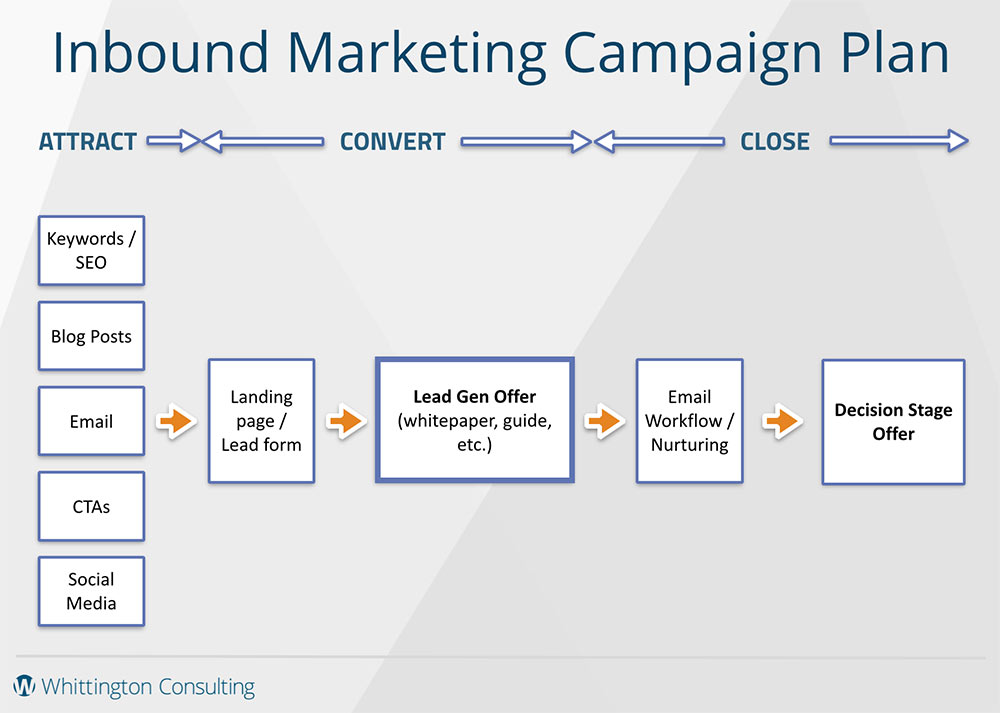Inbound marketing can provide incredible results for companies across a number of hard-to-market industries -- that is, when your inbound marketing strategy has all of the right pieces in place.
Adding a blog to your website without optimizing your website or investing in custom content pieces without an overall strategy simply won’t get you the results you want (see my post from a few days ago). To implement an inbound marketing strategy that meets and exceeds your expectations, you need to make sure your it covers each of the following five strategic must-haves:
1. Strategy that ties tactics together
First and foremost, your inbound marketing strategy should function as a single, well-oiled machine. Everything you do should work with a purpose and as a part of a single system that seeks out qualified customers.
A great example of this overarching strategy is the image of a campaign framework below. Using a plan like this to guide you allows you to see the "big picture" of how your efforts work together to form an overall powerful inbound marketing strategy.

2. Synchronization with offline advertising
Keeping online and offline marketing efforts separate is an outdated way to market your brand.
Effective inbound marketing strategies tie offline demand generation activities like trade shows and print advertising with complementary lead generation activities like links to landing pages for your content offers.
A combined approach will help your online and offline promotional efforts work together to create a cohesive (and captivating) brand in the eyes of your customer. It will generate more leads and work harder for your company, too.
3. Consistent, quality content creation
Inbound marketing blog posts aren’t just for appearances. Each content asset is an opportunity to present your brand and your value proposition to a customer who is hungry for knowledge. My favorite aspect of creating good content is that it is genuinely helpful to your prospective customer.
Regular, informative content for blogs, long-form content like white papers, case studies, and short-form content like social media updates capture the attention of search engines and prospective customers.
To get the most return on each asset, work within a larger strategic content plan. Write each piece of content specifically for your target buyer, and organize them all into a body of knowledge that progressively brings in more qualified traffic.
4. Website optimization
In today’s competitive inbound marketing environment, it's not enough to create good content. You also need to seek out ways to improve your conversion rate and Search Engine Optimization (SEO) proactively.
This is where most companies miss the boat. They are so focused on creating content that they forget to audit their websites to find ways to get people to that content. Companies leave money on the table because they miss lead generation opportunities.
We recommend that you:
- Conduct a full SEO audit of every web page on your corporate website every 3-6 months
- Conduct a conversion audit to find ways to put links to new content on key web pages every 3 months
- Optimize as needed by testing new Call To Action (CTA messaging, placement, and formats on each web page
- Track changes in key metrics such as website bounce rate, monthly leads, conversion rate and website visits
If you aren't improving your website each month, you're quite simply losing opportunities.
5. Measurement and accountability
“Click and pray” is no way to run an effective inbound marketing strategy. Instead, we recommend measuring specific Key Performance Indicators (KPIs) each month so that you can see how you are tracking as you go. This makes it easy to account for your progress over time and allows you to make tactical adjustments as needed.
We do this with a simple Excel spreadsheet where we have our KPIs and the values for the last 13 months. We also have a rolling 3- and 6-month average for the 3-4 most important metrics that drive our business. For us, they are conversion rate, number of leads, visits, and visits from search engines.
Each aspect of your inbound marketing works as a part of a team to deliver higher quality traffic over time. If you focus on one area over all others, you simply won’t see the results you’re capable of.
Does your inbound marketing strategy cover each of these areas? If not, how do you plan to improve it this year?









